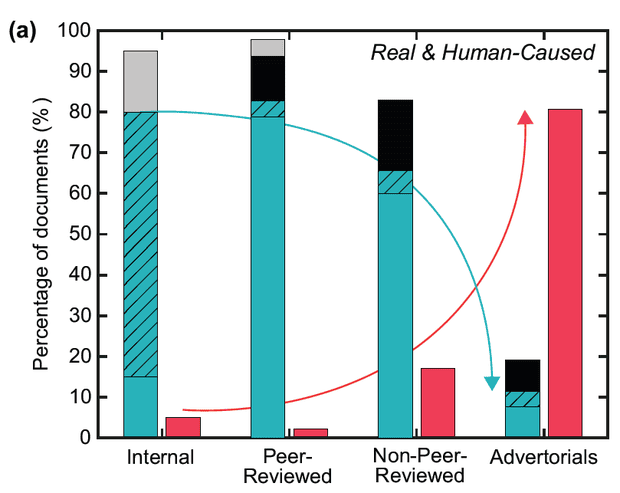
Read all of these documents and make up your own mind.
That was the challenge ExxonMobil issued when investigative journalism by Inside Climate News revealed that while it was at the forefront of climate science research in the 1970s and 1980s, Exxon engaged in a campaign to misinform the public.
Harvard scientists Geoffrey Supran and Naomi Oreskes decided to take up Exxon’s challenge, and have just published their results in the journal Environmental Research Letters. They used a method known as content analysisto analyze 187 public and internal Exxon documents. The results are striking:

Percentage of Exxon document positions on human-caused global warming: expressing only doubt (red), only reasonable doubt (grey), acknowledging but expressing doubt (black), acknowledging and expressing reasonable doubt (black hatch), and only acknowledging human-caused global warming (cyan). Illustration: Supran & Oreskes (2017), Environmental Research Letters.
As Oreskes documented with Erik Conway in Merchants of Doubt, tobacco companies and several other industries that profited from harmful products engaged in decades-long campaigns to sow doubt about the scientific evidence of their hazards. As one R.J. Reynolds Tobacco Company 1969 internal memo read:
Doubt is our product since it is the best means of competing with the ‘body of fact’ that exists in the mind of the general public
The results of this new paper show that Exxon followed this same playbook. While the company’s internal communications and peer-reviewed research were clear about human-caused global warming, its public communications focused heavily on sowing doubt about those scientific conclusions.
For example, Exxon scientist Brian Flannery co-authored a chapter of a 1985 Department of Energy report with NYU professor Martin Hoffert concluding that in a “Low CO2” emissions scenario, humans would cause about 2°C global surface warming above pre-industrial levels by 2100, and about 5°C in a “High CO2” scenario. These projections were in close agreement with those in the latest IPCC report nearly 30 years later.

Temperature increase projected in response to rising carbon dioxide levels. Illustration: Hoffert & Flannery (1985), US Department of Energy report.
Yet in a 1997 advertorial in the New York Times opposing the Kyoto Protocol, Exxon argued:
Nations are being urged to cut emissions without knowing either the severity of the problem – that is, will Earth’s temperature increase over the next 50–100 years? – or the efficacy of the solution – will cutting CO2 emissions reduce the problem?
The advertorial included a misleading graph showing that human activities only account for 3–4% of global carbon dioxide emissions – misleading because the natural carbon cycle is in balance. Earth naturally releases a lot of carbon, but absorbs just as much. Human emissions disrupt that balance and hence are responsible for the entire increase in atmospheric carbon dioxide levels:
these still-unanswered questions (1) Has human activity already begun to change temperature and the climate, and (2) How significant will future change be?
That advertorial included a misleading chart of Sargasso Sea Temperature often used by climate deniers because it gives the appearance that current temperatures are lower than they have been over most of the past millennium. The chart is misleading for two reasons: the Sargasso Sea is one isolated geographic area that doesn’t accurately represent the entire planet, and the data shown on the graph ends roughly a century ago, excluding most human-caused global warming.
Crucially, Exxon’s own climate science research answered these questions 10–20 years before the company published the misleading advertorials. The scientific evidence clearly indicated that by burning fossil fuels like those sold by Exxon, humans were increasing carbon dioxide levels, which were causing global warming, and that this would continue until we stop adding more carbon pollution to the atmosphere.
These were the conclusions of 80% of Exxon’s peer-reviewed research and internal communications, and yet 80% of its advertorials aimed at the public were filled with expressions of doubt and misleading statements and charts that would make today’s climate deniers proud. Doubt was their product, and Exxon has peddled it fiercely.
This study comes as ExxonMobil already faces numerous investigations by state attorneys general and class action lawsuits. One lawsuit accuses Exxon of misleading its investors and inflating its stock value by making false statements about the value of its oil reserves (much of which must be stranded if we’re to meet international climate targets), and about how climate policies will impact the company’s finances.
Posted by dana1981 on Wednesday, 23 August, 2017
 |
The Skeptical Science website by Skeptical Science is licensed under a Creative Commons Attribution 3.0 Unported License. |